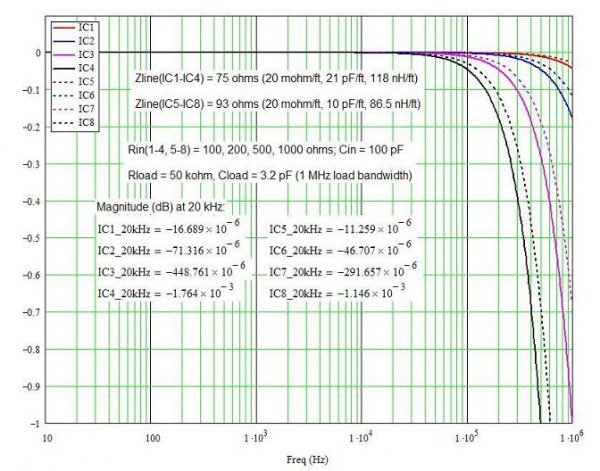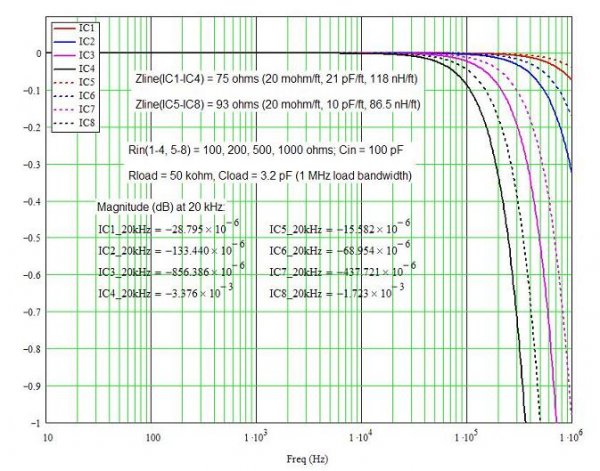I decided to play around with interconnects just a little. Mathematically, that is!
First, I checked a number of preamp, amp, and AVR specs (tube and solid state, from Pioneer to Krell and Audio Research) and found a range of around 20 kohms to 100 kohms input resistance, and none of them specified capacitance. I thought about assuming a 1 MHz input bandwidth, but that was 500 to 1000 pF or so which seemed a little high, so I picked 100 pF. Output impedances of the preamps ranged from around 200 ohms to 500 ohms or so, and with 1 MHz bandwidth the output capacitance is about 3 pF.
I used a couple of interconnects: a pretty standard 75-ohm cable (RG-59; 20 m-ohm, 21 pF, 118 nH per foot), and a low-capacitance cable I have used in the past (RG-63; 93-ohm impedance, 20 m-ohm, 10 pF, 86.5 nH per foot). I used 3 foot and 6 foot lengths (roughly 1m and 2m) in my trials, and distributed the impedance over ten stages/foot for better accuracy (100 stages/foot made essentially no change). I suspect most cables will fall around this range.
In the figures below I used four source (preamp-out) resistances: 100, 200, 500, and 1000 ohms. This spans the range I found plus a bit. I found a range from 0.2 to 0.01 ohms/ft interconnect resistance made no change in the results (<0.1 %). I plotted the frequency response from 10 Hz to 1 MHz, and calculated the response at 20 kHz relative to 10 Hz. There is essentially no significant loss at 20 kHz for any of these tests. Solid lines show 75-ohm cables, and dashed 93-ohm (low-C). Note the vertical scale is only 0.1 dB/division.
As you can see, there is virtually no loss at 20 kHz for any trial (-0.003 dB worst-case). While there can (and probably are) special cases, to me this shows that, for relatively short runs of typical cable and normal preamp/amp designs, there is little likelihood of frequency response being an issue. This does not address shielding or the myriad second and higher order effects that may be present, of course. However, I thought folk might find this interesting.
HTH - Don
First, I checked a number of preamp, amp, and AVR specs (tube and solid state, from Pioneer to Krell and Audio Research) and found a range of around 20 kohms to 100 kohms input resistance, and none of them specified capacitance. I thought about assuming a 1 MHz input bandwidth, but that was 500 to 1000 pF or so which seemed a little high, so I picked 100 pF. Output impedances of the preamps ranged from around 200 ohms to 500 ohms or so, and with 1 MHz bandwidth the output capacitance is about 3 pF.
I used a couple of interconnects: a pretty standard 75-ohm cable (RG-59; 20 m-ohm, 21 pF, 118 nH per foot), and a low-capacitance cable I have used in the past (RG-63; 93-ohm impedance, 20 m-ohm, 10 pF, 86.5 nH per foot). I used 3 foot and 6 foot lengths (roughly 1m and 2m) in my trials, and distributed the impedance over ten stages/foot for better accuracy (100 stages/foot made essentially no change). I suspect most cables will fall around this range.
In the figures below I used four source (preamp-out) resistances: 100, 200, 500, and 1000 ohms. This spans the range I found plus a bit. I found a range from 0.2 to 0.01 ohms/ft interconnect resistance made no change in the results (<0.1 %). I plotted the frequency response from 10 Hz to 1 MHz, and calculated the response at 20 kHz relative to 10 Hz. There is essentially no significant loss at 20 kHz for any of these tests. Solid lines show 75-ohm cables, and dashed 93-ohm (low-C). Note the vertical scale is only 0.1 dB/division.
As you can see, there is virtually no loss at 20 kHz for any trial (-0.003 dB worst-case). While there can (and probably are) special cases, to me this shows that, for relatively short runs of typical cable and normal preamp/amp designs, there is little likelihood of frequency response being an issue. This does not address shielding or the myriad second and higher order effects that may be present, of course. However, I thought folk might find this interesting.
HTH - Don



